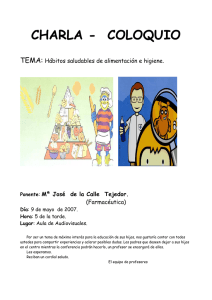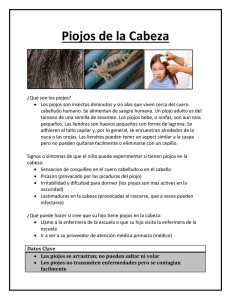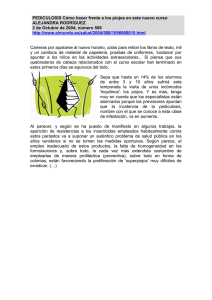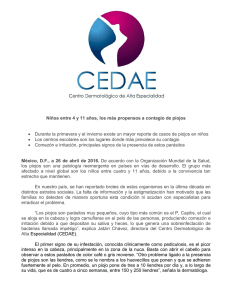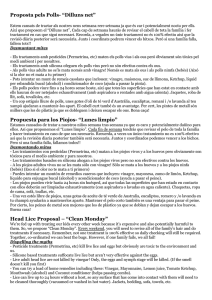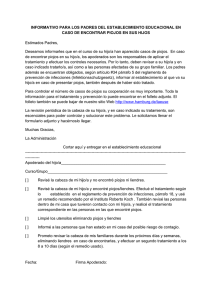Everything you need to know about headlice
Anuncio
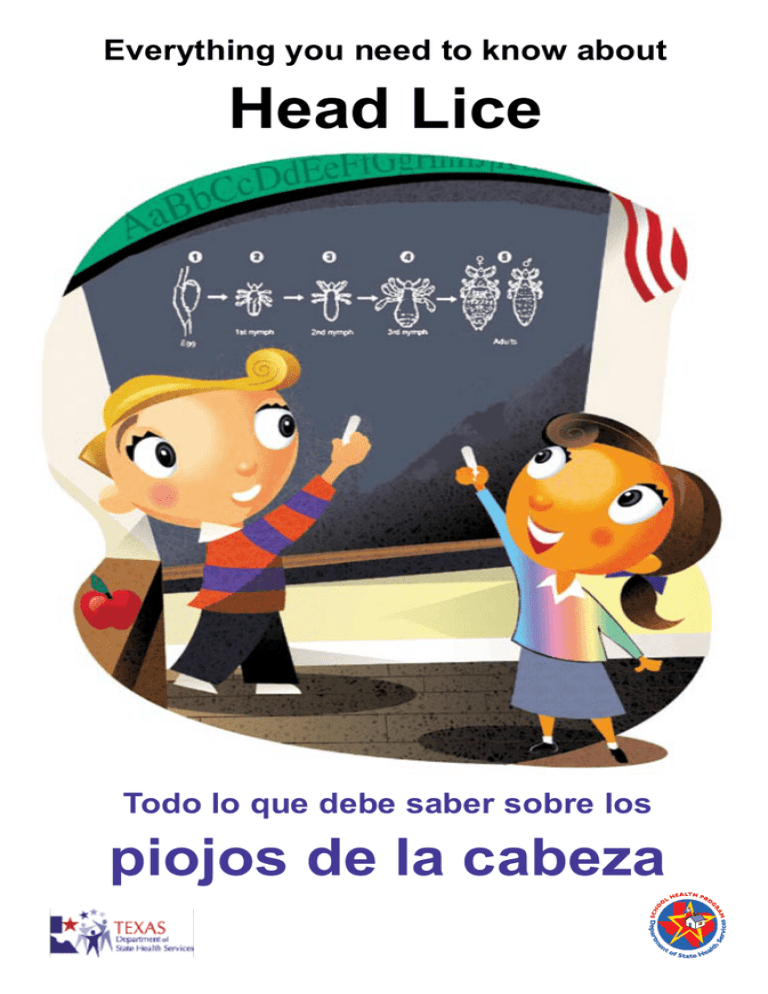
Everything you need to know about Head Lice Todo lo que debe saber sobre los piojos de la cabeza 1 What are lice? Lice are small grayish-white insects, 1/16 to 1/8 inches long, shaped like a football. They don’t usually carry disease, but can cause your child and family discomfort, stress and sometimes skin irritation. ¿Qué son los piojos? Los piojos son insectos pequeños de color blanco grisáceo, de 0.06 a 0.13 pulgadas de largo, en forma de balón de futbol americano. Si bien por lo general no portan enfermedades pueden causar a su hijo y familia molestia, estrés y en ocasiones irritación de la piel. 2 Is there more than one kind of lice that live on our bodies and, where do they live? There are three types of lice: head, body, and crab lice. Body lice have not been reported in Texas for years. Head lice and crab lice are common but not usually found at the same time on a person. Here is where they can hide: • Head lice live on the head and rarely leave the body. • Body lice live in the seams and linings of clothing, blankets and sheets and move to the body when feeding. • Crab lice live on the hairy portions of the body. They like the pubic and anal area; but, only on adults. Adults who have pubic lice should be examined for sexually transmitted diseases (STDs). Even though crab lice and STDs are not related, both conditions could be present at the same time. Children rarely get crab lice. However, if a child has crab lice, you may want to suggest they be examined for possible signs of inappropriate contact. ¿Existe más de un tipo de piojos que viva en nuestro cuerpo y dónde viven? Hay tres tipos de piojos: piojos de la cabeza, del cuerpo y del pubis. No se ha informado de piojos del cuerpo en Texas en años. Aunque los piojos de la cabeza y los piojos del pubis son comunes por lo general no se encuentran en la misma persona al mismo tiempo. Se pueden esconder en los siguientes lugares: • Los piojos de la cabeza viven en la cabeza y raramente se van del cuerpo. • Los piojos del cuerpo viven en las bastillas y dobleces de la ropa, las cobijas y las sábanas y se van al cuerpo para alimentarse. • Los piojos del pubis viven en las partes velludas del cuerpo. Prefieren el pubis y la parte anal pero sólo en los adultos. Se debe examinar a los adultos que tengan piojos del pubis para detectar enfermedades venéreas. No obstante los piojos del pubis y las enfermedades venéreas no están relacionados, ambas enfermedades podrían estar presentes al mismo tiempo. Los niños rara vez tienen piojos del pubis. Sin embargo, si un niño los tiene, quizá quiera sugerir que lo examinen para ver si hay indicios de contacto inapropiado. 3 Do all children get head lice? Children get head lice or Pediculosis (pe·dic·u·lo·sis) almost as much as the common cold. Millions get it at least one time, once a year. Children get lice more than teens or adults and, ANY child can get head lice! It does not matter where they live or go to school; how much money they have; or, if boy or girl, black, white or brown. A child is not sick or unclean if they have head lice. Taking baths will not kill lice or keep children from getting lice. And, if a child has head lice, it certainly does not mean they have bad parents. Dealing with lice is difficult, sometimes embarrassing and can be overwhelming to anyone caring for children. See questions #8, #9 and #13 for suggestions on how to get rid of lice. ¿A todos los niños les salen piojos en la cabeza? A los niños les salen piojos en la cabeza o pediculosis (pe-di-cu-lo-sis) tanto como les da el resfriado común. Les salen a millones al menos una vez al año. A los niños les salen piojos más que a los adolescentes y adultos y ¡a CUALQUIER niño pueden salirle piojos en la cabeza! No importa dónde viva o vaya a la escuela, cuánto dinero tenga o si es hombre o mujer o negro o blanco o moreno. 4 Un niño no está enfermo ni es sucio si tiene piojos en la cabeza. Bañarse no mata a los piojos ni impide que le salgan piojos a los niños. Y, que un niño tenga piojos en la cabeza, por supuesto que no significa que tenga malos padres. Lidiar con los piojos es difícil, en ocasiones vergonzoso y puede ser abrumante para cualquier persona que tenga niños a su cargo. Véanse las sugerencias de cómo deshacerse de los piojos en las preguntas número 8, 9 y 13. How would I know if my child has head lice? Itching is the first sign, unless your child has a very light case. Check your child’s head and scalp when scratching begins. Check for lice and their eggs or “nits”. See the answer to question #6 for how to check for nits. ¿Cómo sé si mi hijo tiene piojos en la cabeza? La picazón es la primera señal, a menos que su hijo tenga un caso muy leve. Revísele la cabeza y el cuero cabelludo si se empieza a rascar. Fíjese si tiene piojos y huevos de piojo o “liendres”. Véase la pregunta número 6 para saber cómo buscar liendres. 5 How did my child get head lice? Lice cannot hop, jump or fly. They move from child to child through close body contact. Head to head play or being together on a mat at nap time can spread lice. Sharing combs, brushes, hair bands, hats, caps, coats, and even neck scarves spreads them, too. Sharing a locker or cubbyhole with a lice-infested child is very common. If left behind, lice can attach to your child while sitting on carpets or furniture. Lice can even attach to stuffed toys. ¿Cómo le salieron piojos en la cabeza a mi hijo? Los piojos no saltan, brincan ni vuelan. Se van de un niño a otro mediante el contacto corporal cercano. El contacto de las cabezas al jugar o tomar una siesta juntos en un tapete puede hacer que se peguen los piojos. Otra manera de que se peguen es compartir peines, cepillos, diademas, sombreros, gorras, abrigos y hasta bufandas. También es muy común si se comparte un locker o un compartimento con un niño con piojos. Los piojos se le pueden subir a su hijo si se sienta en alfombras o muebles en que alguien haya dejado piojos. Los piojos hasta pueden subirse a peluches. 6 What is a “nit” and where do they live? A nit is a lice egg. You may see the nits before lice. Each nit is attached to a hair at the scalp with a waterproof, cement-like substance. Nits are on the hairs at the “nape” of the neck (back of the head where the hair stops and the neck begins) and behind the ears. Start here first. They live anywhere; so, look all over the scalp. The grayish-white nits, about 1/32 inch (1 mm) long, are shaped like a long football. ¿Qué son las “liendres” y dónde viven? Una liendre es el huevo del piojo. Podría ver liendres antes que los piojos. Cada liendre se pega al cabello en el cuero cabelludo con una sustancia impermeable semejante al cemento. Se encuentran las liendres en la “nuca” (la parte trasera de la cabeza donde termina el cabello y empieza el cuello) y detrás de las orejas. Empiece ahí. Como viven en cualquier lugar, revise todo el cuero cabelludo. Las liendres blancas grisáceas, de aproximadamente 0.03 pulgadas (1 mm) de largo, tienen forma de balón de fútbol americano alargado. 7 8 How long do lice live and how many eggs do they lay during their life span? Lice live on a body around 30 days while feeding on blood every 3 to 6 hours, and laying from 50 to 150 eggs. The eggs hatch in 5 to 10 days and become adults in 2 weeks. If not on a body, they die after 24 hours. ¿Cuánto viven los piojos y cuántos huevos ponen durante su vida? Los piojos viven en el cuerpo cerca de 30 días y se alimentan de sangre cada 3 a 6 horas y ponen de 50 a 150 huevos. Los piojos salen del huevo en 5 a 10 días y se vuelven adultos en 2 semanas. Si no viven en el cuerpo, se mueren después de 24 horas. What can my family do to avoid becoming infested with head lice? Once in a while, check heads for signs of lice. Teach your children not to share combs, brushes, hair bands, hats, coats, and even neck scarves. Remind them not to share nap mats, pillows, beds, stuffed toys and even sit too closely on furniture. Think about separating jackets from other students (e.g., separate pegs, storage areas, or backs of their own chairs). Help schools find other ways to stay free from lice (see question #11). ¿Qué puede hacer mi familia para evitar infestarse con piojos en la cabeza? De vez en cuando, revísele el cabello a todos para ver si tienen piojos. Enseñe a sus hijos a no compartir peines, cepillos, diademas, sombreros, gorras, abrigos y hasta bufandas. Recuérdeles no compartir tapetes para dormir la siesta, almohadas, camas, peluches ni si quiera sentarse demasiado cerca de los demás en los muebles. Piense en separarles sus chaquetas de las de los demás estudiantes (p. ej., en percheros y áreas de almacenaje separadas o los respaldos de sus propias sillas). Colabore con las escuelas para encontrar otras formas de no tener piojos (véase la pregunta 11). 9 What should I do if I think my child has lice? You can take care of your child’s head lice problem at home without a visit to the doctor or clinic. Treatments can be purchased without a prescription at pharmacies or grocery stores. Many parents feel embarrassed when their child has lice. Sometimes it helps to talk to someone experienced in talking to parents of children with a head lice problem. The nurse at your child’s school, your doctor, and even the pharmacist can help. Other places trained to answer your questions: • Health care providers at your neighborhood or city health clinic • City or county health departments • Your area Department of State Health Services (DSHS) public health region. See the Resources section to locate Public health Regional offices. ¿Qué debo hacer si creo que mi hijo tiene piojos? Puede resolver el problema de los piojos en la cabeza de su hijo en casa sin ir a consulta con el doctor o a una clínica. Puede comprar tratamientos sin receta en farmacias o tiendas de comestibles. Muchos padres se avergüenzan si su hijo tiene piojos. A veces ayuda hablar con alguien con experiencia en hablar con padres con hijos con el problema de los piojos en la cabeza. La enfermera de la escuela de su hijo, su doctor y hasta su farmacéutico puede ayudar. Otros lugares capacitados para responder a sus preguntas: • Los proveedores sanitarios de su zona o la clínica de salud local • Los departamentos de salud de la ciudad o el condado • La región de salud pública del Departamento Estatal de Servicios de Salud de Texas (DSHS) en su área. Véase la sección Recursos para localizar las oficinas regionales de salud pública. Why do I have to treat my child’s hair two times? 10 After the first treatment, you may not see live lice but you might see nits. If the nits are stuck to strands of hair 1/4 inch (6 mm) or higher from your child’s scalp they are more than likely dead. However, if you see either live lice in the hair or, nits attached to strands of hair 1/4 inch or less from the scalp, than a second treatment is necessary. The closer the nit is to the scalp, the more recent the egg has been laid. This means live lice could be living somewhere on your child’s head. If you do not kill the nits, they will hatch and your child will have lice again – this time without any contact with another infested child! All products specifically created to treat head lice will recommended a second treatment in order to kill the nits. ¿Por qué debo tratar el cabello de mi hijo dos veces? Tras el primer tratamiento, podría no ver piojos vivos pero podría ver liendres. Si las liendres están pegadas al cabello a 0.25 (6 mm) pulgadas o más del cuero cabelludo del niño es muy posible que estén muertas. Sin embargo, si ve ya sea piojos vivos en el cabello o liendres pegadas al cabello a 0.25 pulgadas o menos del cuero cabelludo, es necesario un segundo tratamiento. Entre más cerca esté la liendre del cuero cabelludo, lo más reciente que es el huevo. Eso significa que podría haber piojos vivos en algún lugar de la cabeza de su hijo. Si no mata a las liendres, saldrán del huevo y su niño tendrá piojos otra vez –¡esta vez sin contacto con otro niño infestado! Todos los productos creados específicamente para tratar los piojos de la cabeza recomiendan un segundo tratamiento para matar las liendres.. How do I know if I really got rid of all the lice after treating my child’s hair? • Carefully follow the directions on the lice treatment package. If you think it is not working; try again. Not following directions, is the biggest reason given for why treatment does not work. • Take out the nits, left after treatment and lice are gone. This is called “nit picking.” This must happen after first and second treatments. Nit picking means removing any left over nits from every strand of hair on your child’s head (See question #6). Do this by sliding a nit up the hair shaft with your fingers or nit comb. Special nit picking combs are available in the store where you bought the lice treatment. • Help your children, family, extended family members and friends know how lice is spread and treated. • Help the school do the right things to teach children and parents how to stop the spread of lice. • Check your child’s hair from time to time for signs of lice. Catching it early, can cut down the number of treatments, saving time and money. ¿Cómo sé si en realidad me deshice de todos los piojos después de tratar el cabello de mi hijo? • Siga con cuidado el modo de empleo del paquete del tratamiento para piojos. Si cree que no funciona; intente de nuevo. No seguir el modo de empleo es la razón principal de que el tratamiento no funcione. • Quite las liendres que queden después del tratamiento y no habrá más piojos. A eso se le llama “espulgar” y debe hacerse después del primer y segundo tratamiento. Espulgar significa quitar las liendres restantes de cada uno de los cabellos de la cabeza de su hijo (véase la pregunta número 6). Hágalo deslizando la liendre por el tallo capilar con los dedos o el peine para liendres. Hay peines para liendres de metal especiales en la tienda en que compró el tratamiento para piojos. • Ayude a que sus hijos, familia, familiares lejanos y amigos sepan cómo se pegan y tratan los piojos. • Ayude a la escuela a hacer lo correcto para educar a los niños y padres sobre cómo detener la propagación de los piojos. • Revise el cabello de su hijo de vez en cuando para ver si tiene señas de piojos. Identificarlos a tiempo puede reducir el número de tratamientos y ahorrar tiempo y dinero. 11 12 Can the school send my child home if found with lice or nits? Yes. Texas law gives schools authority to send your child home if live lice are found in their hair. However, the law doesn’t include finding nits. The law also states that your child is allowed to return to school after one medicated shampoo or lotion treatment has been given. When your child returns to school, a head check is not required by law and there is no requirement to report cases of head lice to DSHS. Each school district can make their rules tougher if they choose. And, many do. Talk to the school nurse or someone else in charge, to find out the rules in your child’s school. The DSHS School Health Program has a guide titled Recommended Guidelines for the Management of Pediculosis in School Settings. It is free of charge. You can order it online from the DSHS publications department, call the School Health Program office or visit the School Health Program Web site and print out a free copy. Information on how to access this and other resources is in this brochure’s Resources section. ¿Puede la escuela mandar a mi hijo a casa si le encuentran piojos o liendres? Sí. La ley de Texas da a las escuelas la autoridad de mandar a su hijo a casa si le encuentra piojos en el pelo. Sin embargo, la ley no incluye que encuentre liendres. La ley también dice que se permite que su hijo vuelva a clases tras un tratamiento de champú o loción medicinal. La ley no exige que se le revise la cabeza a su hijo al volver a la escuela y no existe ningún requisito de informar al DSHS de casos de piojos en la cabeza. Cada distrito escolar puede endurecer su reglamento si así lo desea. Y muchos lo hacen. Hable con la enfermera de la escuela o alguien más a cargo, para informarse sobre el reglamento de la escuela de su hijo. El Programa de Salud Escolar del DSHS tiene una guía titulada Pautas recomendadas para el control de la pediculosis en el entorno escolar. Y es gratuita. Puede pedirla en línea al departamento de publicaciones del DSHS, llamando a la oficina del Programa de Salud Escolar o visitando el sitio web del Programa de Salud Escolar e imprimiendo una copia gratuita. Encontrará información sobre cómo acceder a este u otros recursos en la sección de Recursos del folleto. How can I kill the lice in my child’s bedding and clothing and around my house? Here are several suggestions: • Launder clothing and bedding in water at least 130 degrees. ∆ CAUTION: Do not bathe or shampoo in water this hot! This temperature is for laundry only! ∆ Washing clothes and bedding has to be done two days before you do the lice treatment on your child’s hair! • Dry cleaning kills lice and their nits in clothing that can be dry-cleaned. • Sealing clothing, stuffed toys, pillows, blankets or other small soft items for two weeks in tightly closed plastic bags will kill both lice and nits. It’s low cost too! • Safe, effective, FDA approved chemical sprays made to kill head lice, are available over the counter. These are OK to use at home, school, in the car, or on things that can’t be washed, dry-cleaned, or sealed in a plastic bag like furniture, carpets, car seats or any other large, immobile or non-washable item. • Vacuum carpets, furniture and curtains. 13 ¿Cómo puedo matar los piojos en la ropa de cama y de vestir de mi hijo y de la casa? Las siguientes son algunas sugerencias: • Lave la ropa de vestir y de cama a al menos 130 grados. ∆ PRECAUCIÓN: ¡no se bañe o lave el pelo en agua así de caliente! ¡Esa temperatura es sólo para lavar la ropa! ∆ ¡Debe lavar la ropa de vestir y de cama dos días antes de aplicar el tratamiento para piojos al pelo de a su hijo! • La limpieza en tintorería mata los piojos y liendres en la ropa de tintorería. • Meter la ropa, peluches, almohadas, cobijas y objetos blandos pequeños por dos semanas en bolsas plásticas fuertemente selladas mata tanto a los piojos como a las liendres. ¡Y también es muy económico! • Hay aerosoles químicos seguros y efectivos aprobados por la Administración Federal de Fármacos y Alimentos (FDA) hechos para matar a los piojos en la cabeza que se pueden comprar sin receta. Y se pueden usar en la casa, en la escuela, en el auto o en cosas que no se pueden lavar, limpiar en tintorería o meter en bolsas plásticas selladas como muebles, alfombras, asientos de auto infantiles o cualquier otro artículo grande e inmóvil no lavable. • Pase la aspiradora a las alfombras, muebles y cortinas. 14 15 How are combs and brushes treated? Soak combs, brushes and other washable items for 1 hour in one of the approved lice shampoos or, soak them for 5 to 10 minutes in a pan of 130 degree water. ¿Cómo se tratan los peines y cepillos? Sumerja los peines, cepillos y demás artículos lavables por 1 hora en uno de los champús para piojos aprobados o sumérjalos de 5 a 10 minutos en una cacerola con agua a 130 grados. Should I spray, dust or otherwise treat my house or ask the same for my child’s school building when children are found to have lice? Lice don’t hide in building cracks like cockroaches. Treating homes or schools with bug sprays or other pesticides would be a waste of money and could harm your family at home or children and teachers at school. Simply vacuuming carpets and furniture as described in question #13 can get rid of any lice in these places. ¿Debería fumigar mi casa rociando, espolvoreando o tratándola de alguna otra manera o pedir que hagan lo mismo en la escuela de mi hijo si le encuentran piojos a los niños? Los piojos no se esconden en las grietas de los edificios como las cucarachas. Así que el tratamiento de casas o escuelas con insecticidas o algún otro pesticida sería una pérdida de dinero y podría dañar a su familia en casa o a los niños y maestros en la escuela. Con simplemente aspirar las alfombras y muebles según describe la pregunta número 13 se puede deshacer de los piojos en dichos lugares. 16 What should NOT be used to control lice? • Do not use hair dryers! The temperature would have to be turned up so high it could cause serious burns on the scalp. • Do not use poisons or flammable liquids like gasoline, kerosene; and, paint thinner or insect repellant. Chemicals should never be used for the treatment of head lice unless they are approved by the FDA. • Do not spend extra money on hair oils, gels, hairspray, or other non-medicated hair products including dandruff shampoo. They do not kill lice or prevent eggs from sticking to the hair or hatching. • Do not use old-fashion remedies! Vinegar rinses do not kill lice. Nits will still hatch lice and your child will be infested again. • Put those scissors away! Do not cut your child’s hair to get rid of lice. Lice stick to short too! Waiting 7 to 10 days between the first and second treatments will give you the best chance for success; and, spending more time working in the medication throughout our child’s hair during treatments will also help. 16 ¿Qué NO se debe usar para controlar los piojos? • ¡No utilice secadoras de pelo! La temperatura se tendría que subir tanto que podría causar quemaduras serias al cuero cabelludo. • No utilice venenos o líquidos inflamables como gasolina, queroseno ni disolvente ni repelente de insectos. Nunca se deben usar químicos para tratar piojos de la cabeza a menos que la FDA los apruebe. • No gaste dinero extra en aceites, geles, fijadores o algún otro producto no medicinal para el cabello incluso champú anticaspa. No matan a los piojos ni impiden que los huevos se peguen al cabello o maduren. • ¡No use remedios anticuados! Los enjuagues con vinagre no matan a los piojos. Aun así saldrían piojos de los huevos y su hijo se infestaría otra vez. • ¡Guarde las tijeras! No tiene que cortar el bonito cabello de su hijo para deshacerse de los piojos. ¡Los piojos se pegan al cabello corto también! Si espera de 7 a 10 días del primer tratamiento al segundo tendrá mejor posibilidad de salir victorioso, y también ayuda frotar el medicamento en el cabello del niño por más tiempo durante los tratamientos. Resources Visit these Web sites, materials, and other resources from the Department of State Health Services and related organizations for more information about this subject and other school health issues. Web Sites: • DSHS School Health Program: www.dshs.state.tx.us/schoolhealth/ • DSHS Infectious Disease Control Unit: www.dshs.state.tx.us/idcu/disease/headlice/ • Center for Disease Control and Prevention (CDC) – Division of Parasitic Diseases: www.cdc.gov/ncidod/dpd/parasites/lice/ • DSHS Public Health Regions – To find your public health region call: Regional Liaison Services: 512-458-7111 ext. 7297 or visit: www.dshs.state.tx.us/regions • Harvard School of Public Health – Head Lice Information and Frequently Asked Questions www.hsph.harvard.edu/headlice.html • DSHS Publications Department for ordering materials/pamphlets and guides on line: http://dbs.dshs.state.tx.us/mamd/litcat/default.asp Materials: • Recommended Guidelines for the Management of pediculosis in School Settings – DSHS, School Health Program (Stock #1-90) recommended for school nurses, SHACs, principals, other administrators. Order online at: http://dbs.dshs.state.tx.us/mamd/litcat/default.asp or to download a copy go to: www.dshs.state.tx.us/schoolhealth/lice.shtm • School Health Manual – DSHS School Health Program – (recommended for school nurse or nurse administrator) www.dshs.state.tx.us/schoolhealth/pgtoc.shtm • Texas Health and Safety Code: Title 2, Chapter 38 - Pediculosis of Minors www.capitol.state.tx.us/statutes/hs.toc.htm • Communicable Disease Chart For Schools and Child Care Centers: www.dshs.state.tx.us/idcu/health/schools_childcare/resources/ ChildCareChart.pdf Recursos Visite los sitios web y demás recursos del Departamento Estatal de Servicios de Salud y organizaciones relacionadas para informarse sobre el tema y otras cuestiones de salud escolar. Sitios web: • Programa de Salud Escolar del DSHS: www.dshs.state.tx.us/schoolhealth/ • Unidad de Control de Enfermedades Infecciosas del DSHS: www.dshs.state.tx.us/idcu/disease/headlice/ • Centro para el Control y la Prevención de Enfermedades (CDC) –División para Enfermedades Parasíticas: www.cdc.gov/ncidod/dpd/parasites/lice/ • Regiones de salud pública del DSHS –para ubicar su región de salud pública llame a: Servicios Coordinadores Regionales: 512-458-7111, extensión 7297, o bien visite: www.dshs.state.tx.us/regions • Facultad de Salud Pública Harvard –Información sobre piojos de la cabeza y preguntas frecuentes www.hsph.harvard.edu/headlice.html • Departamento de Publicaciones del DSHS para pedidos de materiales, folletos y guías en línea: http://dbs.dshs.state.tx.us/mamd/litcat/default.asp Materiales: • Pautas recomendadas para el control de la pediculosis en el entorno escolar – Programa de salud escolar del DSHS (número de serie 1-190) (recomendado para enfermeras escolares, consejos asesores de salud escolar (SHAC), directores y demás administradores). Haga su pedido en línea en: http://dbs.dshs.state.tx.us/mamd/litcat/default.asp. • Manual de salud escolar –Programa de salud escolar del DSHS – (recomendado para enfermeras o administradores de enfermería escolares) www.dshs.state.tx.us/schoolhealth/pgtoc.shtm • Código de Salud y Seguridad de Texas: título 2, capítulo 38 Pediculosis infantil www.capitol.state.tx.us/statutes/hs.toc.htm • Gráfico de enfermedades transmisibles para escuelas y guarderías infantiles: www.dshs.state.tx.us/idcu/health/schools_childcare/resources/ ChildCareChart.pdf Share What You Learned! Please copy and share this pamphlet with other parents through your PTA or PTO, school events, or extra curricular activities. Suggest school staff use it as an insert in a take-home newsletter, post on the school or district Web site or send home with students as a stand-alone piece. If you prefer, up to 100 copies can be ordered through the DSHS publications department link shown in the Resources section. Also, whenever you get the opportunity, help talk to other parents looking for answers about head lice. Thank you for contacting DSHS for answers. #1-29 ¡Comparta lo aprendido! Sírvase copiar y compartir este folleto con otros padres de familia en su asociación u organización de padres y maestros, en eventos escolares y en actividades extracurriculares. Sugiera que el personal escolar lo use como encarte del boletín informativo para llevar a casa, publíquelo en el sitio web de la escuela o del distrito o envíelo a las casas con los estudiantes aparte. Si lo prefiere, puede pedir hasta 100 copias mediante el enlace del Departamento de Publicaciones del DSHS que aparece en esta sección de Recursos. Asimismo, cuando haya oportunidad, hable con otros padres de familia que tengan preguntas sobre los piojos de la cabeza. Agradecemos que se haya comunicado con el DSHS para obtener respuestas. Department of State Health Services School Health Program 1100 West 49th Street Austin, Texas 78756 512-458-7279 [email protected] www.dshs.state.tx.us/schoolhealth 09/2006
